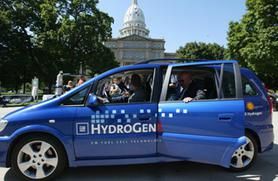This post, part of a series we're running all about electric cars, was written by Christopher Lampton from HowStuffWorks.com.
Most people know by now what an electric car is. It's a car that runs on a battery-powered electric motor. Unlike most cars on the road today, it lacks an internal combustion engine and uses electricity as its fuel rather than gasoline. Because it doesn't burn fossil fuels to make itself run, it doesn't produce any pollution while it's in operation. This, at least in theory, makes electric cars a very green form of transportation.
Advertisement
But what in the world is a hydrogen fuel cell car? It's also a kind of electric car. It runs on a motor powered by electricity. What makes it different from a battery-electric vehicle (or BEV) is where the electricity comes from. Instead of a battery, a hydrogen fuel cell car has, well, a hydrogen fuel cell. This is a device that takes hydrogen, the most abundant element in the universe, and generates electricity from it while the car is running. In effect, a hydrogen fuel cell is a kind of battery that makes electricity on the fly.
To see how this works, let's take a quick refresher course in high school chemistry. (Don't worry; we'll make this as painless as possible.) Hydrogen is the smallest, lightest atom in existence. A standard-issue hydrogen atom consists of two things: a proton (which has a positive electric charge) and an electron (which has a negative electric charge). The hydrogen fuel cell strips these two things apart, so that the electrons are free to go their own way and become the electricity that runs the car's motor. (Electricity Is nothing more a continuous flow of electrons.) Meanwhile, the proton becomes a hydrogen ion -- that is, a hydrogen atom with a positive electric charge -- and will bond together with any oxygen atoms in the vicinity to form water. (Water – or H2O as the chemistry geeks call it – is nothing more than two hydrogen ions with an oxygen atom attached.) This process releases a lot of heat, so the water becomes steam and the steam becomes the exhaust of the hydrogen fuel cell.
The great thing – and the green thing – about both electric cars and hydrogen fuel cell cars is that they don't produce any pollution at the tailpipe (unless you consider the steam being produced by the hydrogen fuel cell to be a form of pollution). So no matter whether you decide to buy an electric car or a hydrogen fuel cell car (though the latter isn't likely to be widely available to customers for quite a few years yet), you'll be helping to save the earth's atmosphere, right?
Well, not exactly. While neither type of car produces pollution at the tailpipe, they both have the potential to produce pollution when their "fuel" is created. The fuel that an electric car runs on is electricity (which is used to charge the batteries) and the fuel that a hydrogen fuel cell car runs on is hydrogen (which is used to generate electricity). That electricity and that hydrogen have to come from somewhere. The electricity will mostly come from power plants that in the majority of cases are burning fossil fuels to produce that electricity and those fossil fuels will cause the same pollution that the electric car is intended to avoid. The hydrogen for the fuel cell vehicle will most likely be produced in the future by electrolysis, which involves passing electricity through water. And that electricity will come from the same potentially polluting sources as the electricity used to charge the electric car's batteries.
The truth is, electric cars and hydrogen fuel cell cars both have the potential to be wonderfully non-polluting forms of transportation, but to make them truly green we'll need to move away from methods of producing electricity that burn fossil fuels. Instead of burning coal to generate electricity, we'll need to concentrate on environmentally clean methods like hydropower, solar power, wind power and nuclear power, which produce little or no polluting emissions. When the day comes that most of our electricity comes from these sources, the electric car and the hydrogen fuel cell car will both be nearly perfect forms of green, non-polluting transportation.
Advertisement
